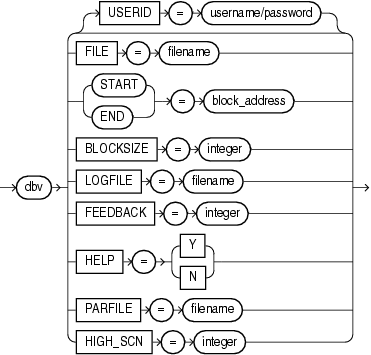Using DBVERIFY to Validate Disk Blocks of a Single Data File
In this mode, DBVERIFY scans one or more disk blocks of a single data file and performs page checks.
DBVERIFY Syntax When Validating Blocks of a Single File
The syntax for DBVERIFY when you want to validate disk blocks of a single data file is as follows:
DBVERIFY Parameters When Validating Blocks of a Single File
Descriptions of the DBVERIFY parameters used to validate blocks of a single file are as follows:
| Parameter | Description |
|---|---|
|
|
Specifies your username and password. This parameter is only necessary when the files being verified are Oracle ASM files. |
|
|
The name of the database file to verify. |
|
|
The starting block address to verify. Specify block addresses in Oracle blocks (as opposed to operating system blocks). If you do not specify |
|
|
The ending block address to verify. If you do not specify |
|
|
|
|
|
When a value is specified for This parameter is optional. There is no default. |
|
|
Specifies the file to which logging information should be written. The default sends output to the terminal display. |
|
|
Causes DBVERIFY to send a progress display to the terminal in the form of a single period (.) for |
|
|
Provides online help. |
|
|
Specifies the name of the parameter file to use. You can store various values for DBVERIFY parameters in flat files. This enables you to customize parameter files to handle different types of data files and to perform specific types of integrity checks on data files. |
Sample DBVERIFY Output For a Single Data File
The following is a sample verification of the file t_db1.dbf.The feedback parameter has been given the value 100 to display one period (.) for every 100 pages processed. A portion of the resulting output is also shown.
% dbv FILE=t_db1.dbf FEEDBACK=100 . . . DBVERIFY - Verification starting : FILE = t_db1.dbf ................................................................................ DBVERIFY - Verification complete Total Pages Examined : 9216 Total Pages Processed (Data) : 2044 Total Pages Failing (Data) : 0 Total Pages Processed (Index): 733 Total Pages Failing (Index): 0 Total Pages Empty : 5686 Total Pages Marked Corrupt : 0 Total Pages Influx : 0
Notes:
-
Pages = Blocks
-
Total Pages Examined = number of blocks in the file
-
Total Pages Processed = number of blocks that were verified (formatted blocks)
-
Total Pages Failing (Data) = number of blocks that failed the data block checking routine
-
Total Pages Failing (Index) = number of blocks that failed the index block checking routine
-
Total Pages Marked Corrupt = number of blocks for which the cache header is invalid, thereby making it impossible for DBVERIFY to identify the block type
-
Total Pages Influx = number of blocks that are being read and written to at the same time. If the database is open when DBVERIFY is run, then DBVERIFY reads blocks multiple times to get a consistent image. But because the database is open, there may be blocks that are being read and written to at the same time (INFLUX). DBVERIFY cannot get a consistent image of pages that are in flux.
